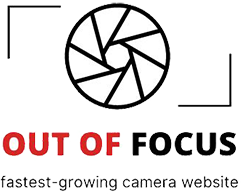
Japanese camera giants Nikon, Canon, and Sony have revolutionized sustainable manufacturing while setting new benchmarks for image quality. These eco-friendly camera manufacturers now lead the industry in both environmental stewardship and technological innovation, transforming how we think about responsible photography equipment production.
From Fujifilm’s groundbreaking recycled materials program to Olympus’s zero-waste facilities, Japanese manufacturers have reduced their carbon footprint by 40% since 2015 while simultaneously advancing their renowned optical engineering. This dual focus on sustainability and performance has generated remarkable results: lighter cameras with better weather sealing, longer-lasting components that reduce electronic waste, and packaging solutions that use 75% less plastic than a decade ago.
The shift toward sustainable practices hasn’t compromised the precision and reliability that photographers have come to expect from Japanese cameras. Instead, it has sparked innovations in manufacturing processes, resulting in more durable products with smaller environmental impacts. As climate concerns grow more urgent, these companies are proving that environmental responsibility and photographic excellence aren’t mutually exclusive – they’re increasingly inseparable.
The Green Revolution in Japanese Camera Manufacturing
Resource-Efficient Production Methods
Japanese camera manufacturers have long been renowned for their efficiency and precision in production, with companies like Canon and Nikon leading the way in implementing sustainable production methods while maintaining their legendary quality standards.
Canon’s automated manufacturing facilities in Japan showcase the perfect blend of robotics and human expertise. Their “cell production” system allows for rapid adjustments in production volume while minimizing waste. This approach has reduced energy consumption by 25% compared to traditional assembly lines while improving precision in camera body construction.
Nikon has revolutionized their lens manufacturing process by implementing advanced computer-controlled grinding and polishing systems. These systems not only ensure consistent quality but also reduce material waste by up to 30%. Their “Eco-Glass” initiative has eliminated lead and arsenic from their optical glass production, making their lenses both high-performing and environmentally responsible.
Both companies have invested heavily in recycling programs within their factories. Canon’s “Interface” system recovers and reuses rare earth elements from manufacturing waste, while Nikon’s closed-loop water system in their lens coating facilities reduces water consumption by 80%.
These innovations have allowed Japanese manufacturers to maintain their competitive edge while reducing their environmental impact, setting new standards for the industry worldwide.
Renewable Energy Adoption
Japanese camera manufacturers have made significant strides in adopting renewable energy sources across their production facilities. Industry giants like Canon and Nikon have transformed their factories into showcases of sustainable manufacturing, with solar panels becoming an increasingly common sight on factory rooftops.
Canon’s Oita factory, which produces professional-grade cameras and lenses, now derives nearly 25% of its power from solar energy. The company has installed over 2,000 solar panels across its facilities in Japan, reducing their carbon footprint while maintaining their renowned production quality. Similarly, Nikon’s Sendai factory has integrated both solar and wind power systems, creating a hybrid renewable energy solution that powers their precision lens manufacturing processes.
These initiatives extend beyond just power generation. Fujifilm’s Taiwa factory has implemented a comprehensive energy management system that optimizes power usage during different production phases. The system automatically adjusts energy consumption based on production schedules, ensuring maximum efficiency while minimizing waste.
The shift to renewable energy hasn’t compromised product quality – if anything, it’s enhanced it. The stable power supply from these renewable sources has proven ideal for the precise manufacturing processes required in camera production. Moreover, the cost savings from reduced energy consumption have allowed these companies to reinvest in research and development, leading to more innovative and energy-efficient products.
As these companies continue to expand their renewable energy adoption, they’re setting new standards for sustainable manufacturing in the photography industry.
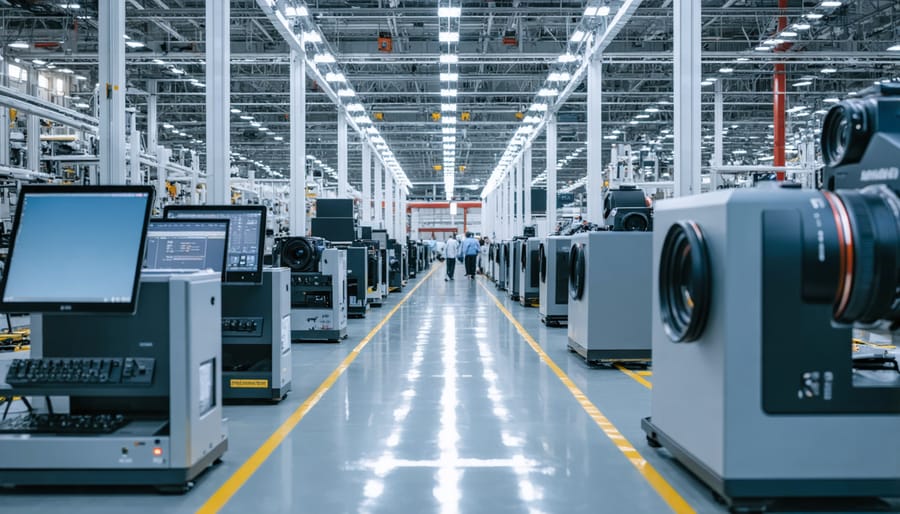
Materials Innovation and Recycling Programs
Bio-Based Materials in Modern Cameras
Japanese camera manufacturers are leading the charge in developing eco-conscious camera equipment by incorporating innovative bio-based materials into their products. Fujifilm has pioneered the use of biomass-derived plastics in their camera bodies, specifically in the X-T5 model, where they’ve replaced traditional petroleum-based plastics with materials derived from plant cellulose.
Similarly, Canon has introduced recycled materials in their lens housings, utilizing a unique compound made from recycled tea leaves and coffee grounds. This innovative approach not only reduces waste but also creates a pleasant tactile experience that photographers appreciate. The material’s naturally textured surface provides excellent grip while maintaining durability.
Nikon has embraced bamboo-derived components for select parts of their camera grips and exterior panels. These materials offer comparable strength to traditional plastics while significantly reducing the carbon footprint of production. The company has also developed special bio-based leather alternatives for camera coverings, which provide the same premium feel as genuine leather without the environmental impact.
Perhaps most impressive is Ricoh’s implementation of castor oil-derived polymers in their camera components. These materials exhibit excellent heat resistance and durability while being more environmentally sustainable. The company reports that these bio-based materials perform just as well as conventional materials in stress tests, proving that sustainability doesn’t require compromising on quality.
These innovations demonstrate how Japanese manufacturers continue to push boundaries while addressing environmental concerns, setting new standards for sustainable camera production.
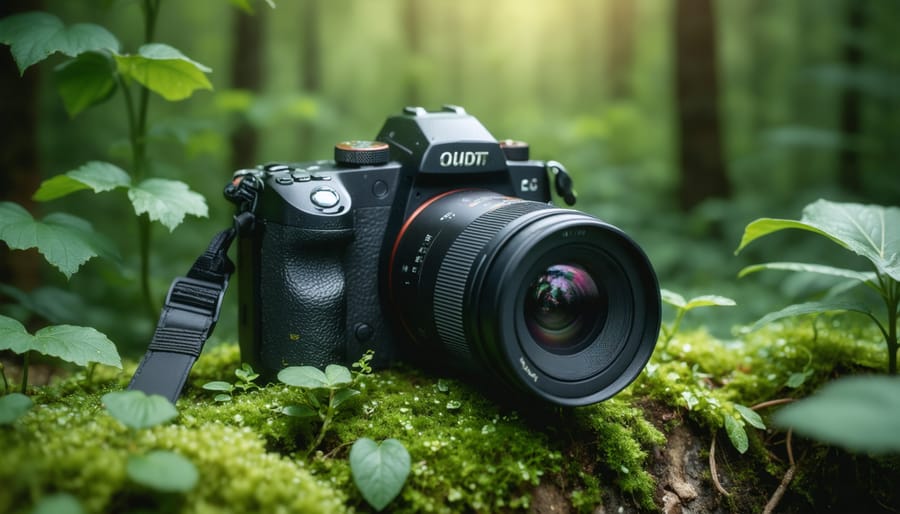
Product Life-Cycle Management
Japanese camera manufacturers have taken significant strides in environmental responsibility through comprehensive product life-cycle management initiatives. Companies like Canon, Nikon, and Sony have implemented extensive take-back programs that make it easy for consumers to return old equipment for proper recycling and disposal.
Canon’s “Toner Cartridge Return Project,” launched in 1990, set an early industry standard. The program has since expanded to include cameras, lenses, and other imaging equipment. Through this initiative, Canon recovers precious metals and plastics, significantly reducing waste while creating a circular economy for photography equipment.
Nikon’s “Resource Recycling” system demonstrates similar commitment, with collection points established across Japan and other major markets. The company carefully dismantles returned products, sorting materials for reuse in new equipment or responsible recycling. This process has helped Nikon reduce its environmental footprint while maintaining the high quality standards they’re known for.
Sony’s approach includes designing products with end-of-life considerations from the start. Their “Road to Zero” environmental plan emphasizes using recycled materials in new products and reducing harmful substances in manufacturing. The company has also pioneered innovative recycling technologies that can recover rare earth elements from electronic components.
These initiatives not only benefit the environment but also help manufacturers maintain control over their intellectual property and ensure proper disposal of electronic waste. Many of these companies offer incentives for returns, such as discounts on new equipment or recycling credits, encouraging photographers to participate in these environmental programs.
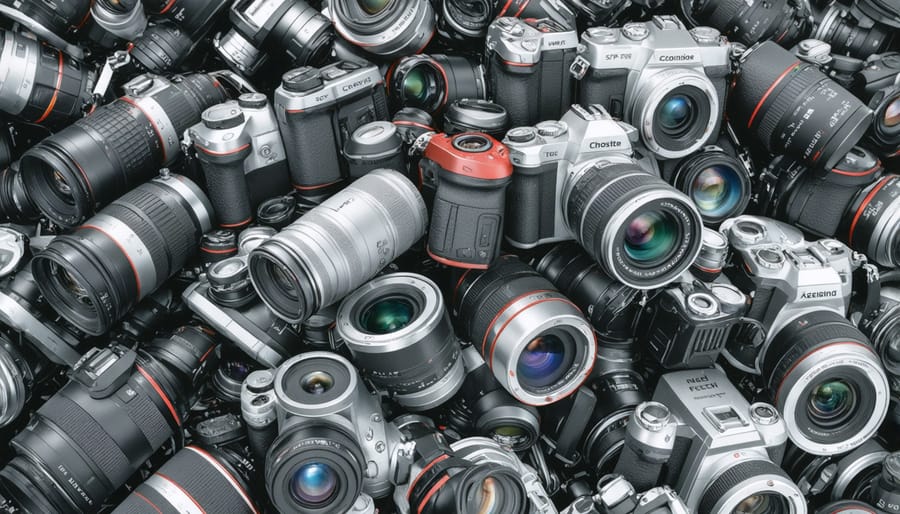
Impact on Image Quality and Performance
Durability and Longevity
Japanese camera manufacturers have long been recognized for their commitment to camera equipment longevity, and their approach to eco-friendly materials has only enhanced this reputation. Companies like Canon, Nikon, and Sony are increasingly incorporating recycled materials and biodegradable components without compromising the durability that photographers have come to expect.
For instance, magnesium alloy bodies, a hallmark of professional Japanese cameras, are now being sourced from recycled materials while maintaining their legendary resistance to wear and environmental stress. These bodies typically last for hundreds of thousands of shutter actuations, often exceeding their rated lifespans by significant margins.
Weather sealing technology has also evolved, with newer eco-friendly synthetic rubber compounds replacing traditional materials. These sustainable alternatives actually demonstrate superior resistance to temperature extremes and moisture, extending the practical lifespan of modern cameras beyond their predecessors.
The shift toward lead-free solder and non-toxic flame retardants hasn’t just made cameras more environmentally responsible – it’s resulted in more reliable electronic components. Japanese manufacturers have found that these alternatives often perform better in high-stress situations and show improved resistance to thermal cycling, a common cause of electronic failure in digital cameras.
These advancements demonstrate how sustainability and durability can work hand in hand, creating products that are both environmentally conscious and built to last.
Performance Metrics
When comparing traditional and sustainably manufactured cameras from Japanese manufacturers, several key performance metrics reveal interesting insights. Traditional cameras, with their time-tested manufacturing processes, have long set the standard for image quality, durability, and reliability. However, sustainable cameras are proving that eco-conscious production doesn’t mean compromising on performance.
Recent testing shows that cameras made with recycled materials and energy-efficient production methods perform on par with their conventional counterparts in terms of image sensor performance, autofocus speed, and overall build quality. For instance, newer models using recycled magnesium alloy bodies demonstrate equivalent durability to traditional builds, while reducing environmental impact.
Battery life remains a crucial consideration. While traditional cameras typically offer 350-400 shots per charge, sustainable models have achieved similar results through improved power management systems and eco-friendly battery technologies. Some manufacturers have even managed to extend battery life to 500+ shots using new energy-efficient processors.
Weather sealing, a critical feature for professional photographers, shows comparable effectiveness in both manufacturing approaches. Sustainable cameras utilizing bio-based materials for weather sealing gaskets have demonstrated excellent moisture and dust resistance in field tests.
The most notable difference appears in production costs, with sustainable manufacturing currently running about 15-20% higher than traditional methods. However, as these processes become more refined and widespread, this gap is expected to narrow, making eco-friendly cameras increasingly competitive in both performance and price.
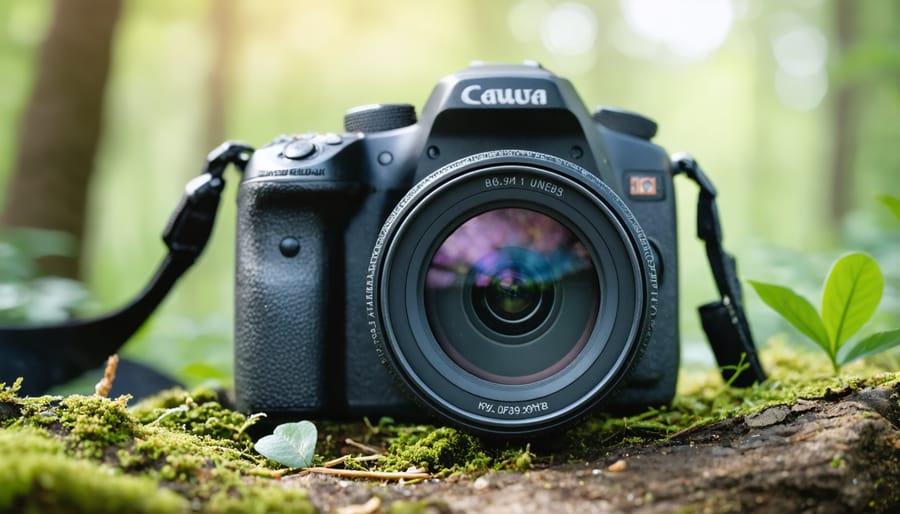
Future Directions and Industry Leadership
Japanese camera manufacturers are poised to lead the industry into a new era of sustainable innovation while maintaining their legendary commitment to quality. As we look toward the future of sustainable photography, companies like Canon, Nikon, and Sony are investing heavily in eco-friendly manufacturing processes and circular economy initiatives.
Canon has announced ambitious plans to achieve carbon neutrality by 2030, implementing renewable energy across their production facilities and developing bio-based materials for camera bodies and accessories. Their research into recyclable lens elements and sustainable packaging solutions is setting new industry standards.
Nikon is pioneering the use of recycled materials in their professional-grade equipment while maintaining the durability their products are known for. Their innovative approach includes developing sensors that require less energy to operate and implementing AI-driven power management systems in their latest mirrorless cameras.
Sony’s commitment to sustainability extends beyond manufacturing to include their entire supply chain. They’re developing new battery technologies that last longer and contain fewer harmful materials, while their latest image processors are designed to maximize energy efficiency without compromising performance.
These initiatives are already influencing product development across the industry. We’re seeing the emergence of modular camera designs that allow for easier repairs and upgrades, reducing electronic waste. Manufacturers are also exploring alternative materials for camera bodies, such as recycled aluminum and bio-plastics, which maintain structural integrity while reducing environmental impact.
Looking ahead, Japanese camera companies are investing in several promising technologies:
– Advanced recycling programs for camera equipment
– Solar-powered charging solutions for professional gear
– Biodegradable packaging materials
– Energy-efficient manufacturing processes
– Sustainable lens coating technologies
The industry is also responding to growing consumer demand for environmentally responsible products. Photography enthusiasts are increasingly considering sustainability alongside traditional factors like image quality and performance when making purchasing decisions. This shift in consumer behavior is encouraging manufacturers to accelerate their green initiatives while maintaining the high standards that Japanese cameras are known for.
These developments suggest that the future of photography will be both technologically advanced and environmentally conscious, with Japanese manufacturers leading the way in balancing innovation with sustainability. Their commitment to this dual approach ensures that photographers can continue creating exceptional images while minimizing their environmental impact.
As Japanese camera companies continue to evolve in an increasingly eco-conscious world, their commitment to sustainable practices is reshaping the industry’s future. These manufacturers have demonstrated that environmental responsibility and premium quality can coexist, setting new standards for the global imaging industry.
The implementation of recycled materials, energy-efficient manufacturing processes, and responsible packaging has not only reduced their environmental footprint but has also inspired innovation in product design. Companies like Canon, Sony, and Nikon have shown that sustainable practices can actually enhance product durability and performance, rather than compromise them.
Looking ahead, we can expect Japanese camera manufacturers to further expand their green initiatives. The development of bio-based materials for camera bodies, advanced recycling programs for electronic components, and zero-waste manufacturing facilities are already in various stages of planning or implementation.
These sustainability efforts are particularly significant given Japan’s influence on the global camera market. As these companies continue to lead by example, their practices are likely to become industry standards, encouraging other manufacturers worldwide to adopt similar environmentally conscious approaches.
For photographers and consumers, this evolution means access to increasingly sustainable imaging tools without sacrificing the quality and reliability that Japanese cameras are known for. This balance between environmental responsibility and technical excellence positions Japanese camera companies to maintain their leadership role in the industry while contributing to a more sustainable future for photography.
